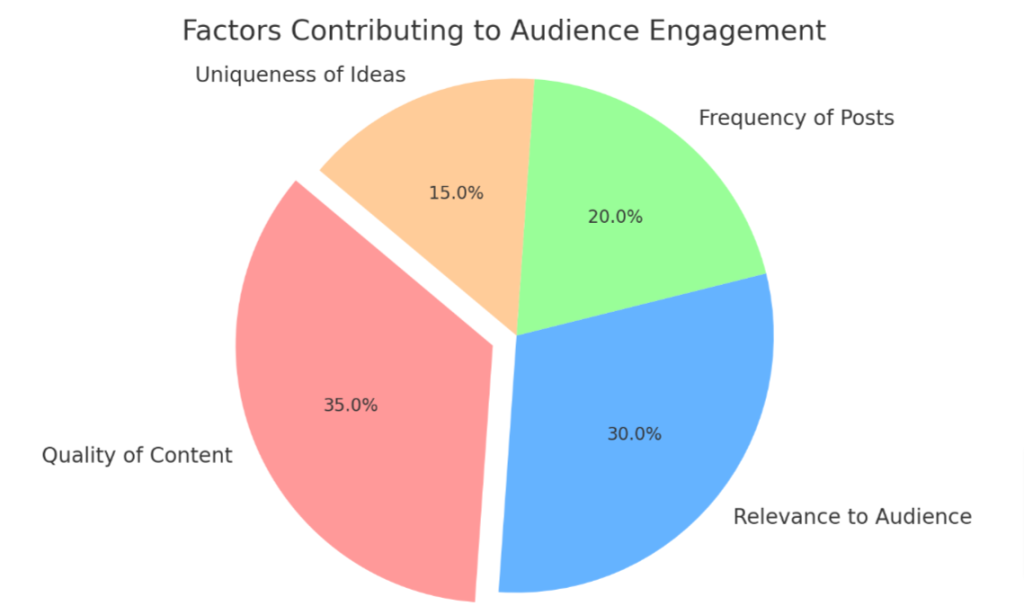Balancing Act: Writing Quality Content for Varied Audiences
Mastering the art of writing for different audiences can seem like walking a tightrope. Striking a balance between churning out tons of content and ensuring its superior quality is paramount, yet challenging in today’s fast-paced digital world.
This blog post is designed to guide you through this labyrinth: giving insight on why both quality and quantity matter, and how to find that perfect equilibrium. Ready? Let’s dive into the heart of effective writing!
Key Takeaways
- Quality in writing means creating well – researched, accurate content that engages readers and enhances your brand’s credibility.
- Quantity in writing refers to producing a high volume of content across different platforms, but maintaining quality can be a challenge.
- Crafting unique and relatable content helps you stand out and connect with your audience while establishing credibility.
- Producing a higher quantity of content allows you to reach a wider audience and improve your writing skills.
Understanding Quality and Quantity in Writing
Quality and quantity in writing are two distinct aspects that play a crucial role in effectively communicating with different audiences.
Definitions and differences
Quality in writing means creating content that is well-researched, accurate, and presented with excellent grammar and punctuation. This type of writing engages the reader, delivers value, and reinforces your brand’s credibility.
On the other hand, quantity in writing refers to producing a high volume of content regardless of its depth or uniqueness. While it allows for more opportunities to reach different audiences across numerous platforms, the challenge lies in maintaining quality while increasing output.
Each approach caters to unique aspects within the field of writing: quality builds trust through insightful and reliable material; quantity increases visibility by regularly populating various channels with fresh perspectives.

However, neither should exist without consideration for the other – they are two sides of the same coin when it comes to effective communication strategies.
The differences lie primarily on emphasis: quality prioritizes intricate care on individual pieces produced less frequently while quantity leans toward macro-level impact achieved by consistent production regardless of deep refinement per piece.
But this does not denote an absolute rule – each situation calls for a judgment based on specific goals related to audience engagement or brand awareness.
Why Quality is Important in Writing
Quality is crucial in writing as it sets you apart, connects with audiences, and establishes credibility. Don’t miss out on the benefits of producing high-quality content! Read more to find out why quality matters in writing.
Setting yourself apart
Crafting unique content sets you apart in a sea of writers. Uniqueness grabs attention and builds your brand reputation. Readers crave original ideas, innovative viewpoints, and fresh insights.
Your style becomes your signature that readers can identify with ease. Stand out by injecting personal experiences or anecdotes into your work to make it more relatable. Implementing an inclusive language also aids in audience-specific writing for diverse readerships which makes them feel recognized within the discourse of your piece.
This differentiates you from others while establishing credibility and assisting in effective communication catering to targeted writing styles for various audiences.
Connecting with audiences
Crafting engaging content is a crucial aspect of connecting with audiences. It demands understanding who your readers are, what interests them, and how best to communicate your ideas to them.
This involves adjusting the language, style, and tone of your writing according to the specific needs and expectations of different reader types. By doing this, writers can resonate more profoundly with their audience, fostering deeper connections while building trust and reliability in their work.
Providing valuable information that meets the demands or solves problems for your readers further solidifies these connections. Thus fine-tuning a piece of writing to fit various audience preferences can significantly enhance its overall impact.
Establishing credibility
Establishing credibility is crucial when it comes to writing, especially if you want to connect with your audience and gain their trust. One way to do this is by providing accurate information that is supported by reliable sources.
By citing credible experts or referencing reputable studies, you can show that you have done your research and are knowledgeable on the subject. Another way to establish credibility is by sharing personal experiences or expertise in the topic at hand.
This lets readers know that you have firsthand knowledge and can provide valuable insights. Overall, establishing credibility helps build a strong foundation for effective communication with your audience, making them more likely to engage with your content and see you as a trusted source of information.
Why Quantity Can Also Be Beneficial
Producing a higher quantity of content allows you to reach a wider audience and attract more readers to your blog or website.
Reaching a wider audience
To reach a wider audience with your writing, strive to produce a high quantity of content without compromising on quality. By consistently putting out useful and unique content that is interesting to your target readers, you can increase brand awareness and engage a larger customer base.
Crafting audience-specific writing and tailoring your language for different reader types will help you connect with diverse audiences and expand your reach. With effective communication, you can successfully adapt your writing style to meet the needs of various audiences and attract new followers or customers.
Improving writing skills
Improving writing skills is a crucial aspect of becoming a better writer. By consistently practicing and honing your craft, you can develop the ability to effectively communicate with different audiences.
This involves paying attention to grammar and punctuation, as well as crafting content that is useful, unique, and interesting. It also helps in establishing brand reputation and engaging the customer base.
So, whether you are writing for specific target audiences or diverse readerships, adapting your writing style and customizing content accordingly will ensure that your message resonates with your intended audience.
Finding the right balance
To find the right balance between quality and quantity in your writing, it’s important to consider your purpose and goals. Determine what you want to achieve with each piece of content, whether it’s to educate, entertain, or promote your brand.
Use analytics to track the success of your posts and make adjustments as needed. Explore different mediums and formats to keep things fresh and engaging for your audience. Prioritize quality while still producing enough content to maintain a consistent presence.
By finding this balance, you can effectively communicate with diverse readerships and tailor your writing style for specific target audiences.

Tips for Finding the Right Balance
Determine the purpose of your writing, track success using analytics, make necessary adjustments, explore different mediums and formats, prioritize quality while still producing enough content.
Determining the purpose of your writing
To write effectively, it is crucial to determine the purpose of your writing. Understanding why you are writing helps you tailor your content to meet the needs of your target audience.
Whether you want to inform, entertain, persuade, or educate, clarifying your purpose guides the tone and structure of your writing. By identifying what you hope to achieve with your work, you can craft a clear and focused message that resonates with your readers.
Using analytics to track success
Tracking success in writing is important for improvement and growth. Here are some ways you can use analytics to measure your progress:
- Analyzing website traffic: Look at the number of page views, unique visitors, and time spent on each page to see which topics and formats resonate most with your audience.
- Monitoring social media engagement: Pay attention to likes, comments, shares, and click-through rates to gauge the effectiveness of your content on different platforms.
- Tracking email open rates: Keep an eye on how many recipients open your emails to assess the relevance and appeal of your subject lines and newsletter content.
- Examining conversion rates: Monitor how many readers take a desired action after consuming your content, such as signing up for a webinar or making a purchase.
- Utilizing keyword analysis: Use tools like Google Analytics to determine which keywords drive the most organic search traffic to your website, helping you optimize future content.
- Testing A/B variations: Experiment with different headlines, layouts, and calls-to-action to see which variations generate the highest engagement and conversions.
Making adjustments as needed
- Evaluate the success of your writing by analyzing engagement metrics and feedback.
- Identify any areas for improvement and make necessary changes to enhance readability and impact.
- Experiment with different writing styles, tones, and formats to cater to diverse audiences.
- Regularly update your content based on current trends, audience interests, and changing preferences.
- Seek input from trusted colleagues or mentors to gain fresh perspectives and insights.
- Stay open – minded and flexible, willing to adapt your writing approach as needed.
- Continuously learn and grow as a writer by seeking feedback, attending workshops, or taking courses.
Exploring different mediums and formats
Exploring different mediums and formats is an effective way to reach a diverse audience and engage them with your writing. Here are some tips for doing so:
- Use social media platforms such as Facebook, Instagram, and Twitter to share your content in various formats like videos, images, and infographics.
- Start a podcast or create audio recordings of your written content for those who prefer listening over reading.
- Experiment with different writing styles, such as personal essays, how – to guides, or opinion pieces, to cater to different reader preferences.
- Consider translating your content into different languages to expand your reach internationally.
- Collaborate with other writers or industry experts to create guest posts or co – authored articles that appeal to new audiences.
- Explore niche platforms or communities where your target audience congregates online and share your content there.
Prioritizing quality while still producing enough content
To succeed in writing for different audiences, it’s crucial to prioritize quality while also producing enough content. This means finding a balance between delivering valuable and well-crafted pieces, while still meeting the demands of your audience.
Quality should always be at the forefront, as it helps set you apart from others and establish credibility. However, it’s important to produce enough content to reach a wider audience, improve your writing skills, and maintain consistency.
By focusing on both quality and quantity, you can effectively engage with diverse reader groups and tailor your writing style to meet their needs.
Conclusion
In conclusion, finding the right balance between quality and quantity is essential when writing for different audiences. By prioritizing high-quality content that is useful, unique, and interesting, you can establish credibility, engage your audience effectively, and build brand reputation.
At the same time, producing enough content to reach a wider audience and improve your writing skills is also important. Remember to tailor your writing style and language to meet the specific needs of each target audience while still maintaining a high level of quality.

